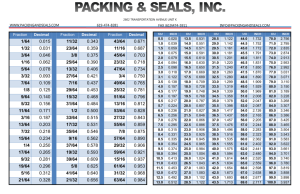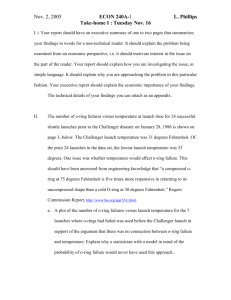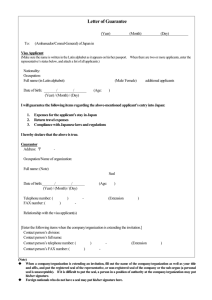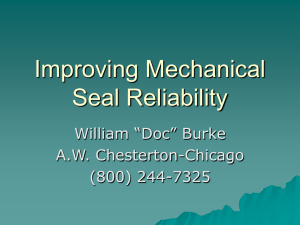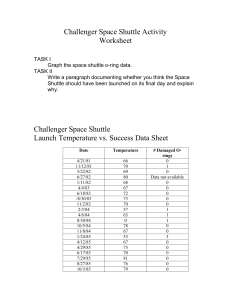Seal Types & Gland Design
advertisement
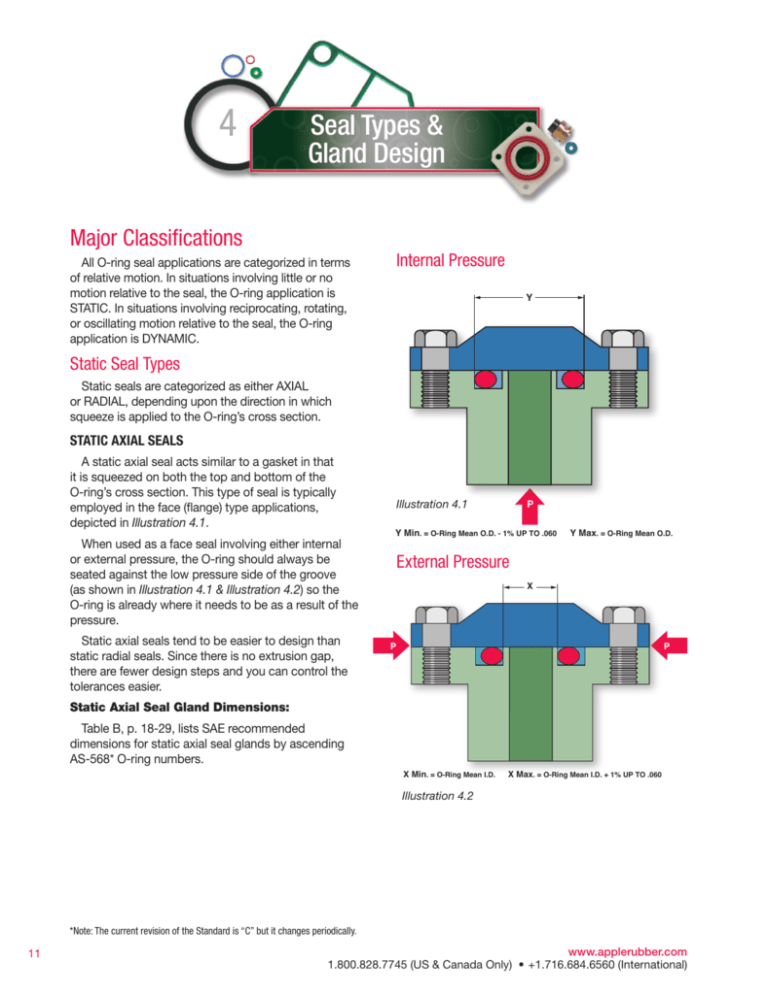
4 Seal Types & Gland Design Major Classifications Internal Pressure All O-ring seal applications are categorized in terms of relative motion. In situations involving little or no motion relative to the seal, the O-ring application is STATIC. In situations involving reciprocating, rotating, or oscillating motion relative to the seal, the O-ring application is DYNAMIC. Y Static Seal Types Static seals are categorized as either AXIAL or RADIAL, depending upon the direction in which squeeze is applied to the O-ring’s cross section. STATIC AXIAL SEALS A static axial seal acts similar to a gasket in that it is squeezed on both the top and bottom of the O-ring’s cross section. This type of seal is typically employed in the face (flange) type applications, depicted in Illustration 4.1. When used as a face seal involving either internal or external pressure, the O-ring should always be seated against the low pressure side of the groove (as shown in Illustration 4.1 & Illustration 4.2) so the O-ring is already where it needs to be as a result of the pressure. Static axial seals tend to be easier to design than static radial seals. Since there is no extrusion gap, there are fewer design steps and you can control the tolerances easier. P Illustration 4.1 Y Min. = O-Ring Mean O.D. - 1% UP TO .060 Y Max. = O-Ring Mean O.D. External Pressure X P P Static Axial Seal Gland Dimensions: Table B, p. 18-29, lists SAE recommended dimensions for static axial seal glands by ascending AS-568* O-ring numbers. X Min. = O-Ring Mean I.D. X Max. = O-Ring Mean I.D. + 1% UP TO .060 Illustration 4.2 *Note: The current revision of the Standard is “C” but it changes periodically. 11 www.applerubber.com 1.800.828.7745 (US & Canada Only) • +1.716.684.6560 (International) STATIC RADIAL SEALS Static Radial Seals are squeezed between the inner and outer surfaces of the O-ring. They are typically employed in cap and plug type applications, as depicted in Illustration 4.3. Static Crush Seal 4 45˚ Static Radial Seal Gland Dimensions: Table C, p. 30-41, lists SAE recommended dimensions for static radial seal glands by ascending AS-568* numbers. Note: Recommended dimensions for static radial seal glands listed in Table C are based on an application pressure limit of 1500 psi. For higher pressure requirements reference Section 5, Illustration 5.1 or contact Apple Rubber for technical assistance. Radial Seal Illustration 4.4 STATIC SEALS WITH DOVETAIL GLANDS O-rings are sometimes employed in static or slow moving dynamic situations calling for specially machined “dovetail” glands. Because of the angles involved, controlling the tolerances in these glands may be difficult. The purpose of these glands is to securely hold the O-ring in place during machine operation and/or maintenance disassembly. A typical valve seat application is shown in Illustration 4.5. Dovetail Gland O-Ring Illustration 4.3 Valve Movement STATIC CRUSH SEALS In crush seal applications, the O-ring is completely confined and pressure deformed (crushed) within a triangular gland made by machining a 45° angle on the male cover. Squeezed at an angle to the O-ring’s axis, crush seals are used in such simple applications as the one depicted in Illustration 4.4. Static Crush Seal Gland Dimensions: Table D, p. 42, lists SAE recommended dimensions for static crush seal glands by ascending AS-568* numbers. Illustration 4.5 Rule of Thumb For a static crush seal application, it is recommended that the O-ring volume does not exceed 95% of the gland void. *Note: The current revision of the Standard is “C” but it changes periodically. www.applerubber.com 1.800.828.7745 (US & Canada Only) • +1.716.684.6560 (International) O-Ring 12 Seal Types & Gland Design In this application, O-ring squeeze is primarily axial in direction (valve operation exerts force on top and bottom seal surfaces). To avoid tearing or nicking, the use of O-ring lubrication is recommended while installing the O-ring into the dovetail gland. Because of the difficulty in creating the groove and tight tolerances required, this type of seal application should only be used when necessary. Dovetail Gland Dimensions: Table E, p. 42, lists SAE recommended dimensions for dovetail glands by ascending AS-568* numbers. Dynamic Seal Types This classification of seals is used in situations involving reciprocating, rotating or oscillating motion. Dynamic seal performance may be substantially affected by a number of operating environmental factors. Such factors include seal swell in fluids, surface finish of hardware components, lubrication, system pressure, thermal cycling, O-ring squeeze, O-ring stretch, and friction. Since many of these factors are interrelated, it is important to consider ALL of them in dynamic sealing situations. In discussions of individual dynamic seal types, therefore, mention will be made of the most critical operating environmental factors to consider. More detailed information on “Critical Operating Environmental Factors” is found in Section 5. RECIPROCATIING SEALS Reciprocating seals, as depicted in Illustration 4.6, are used in situations involving a moving piston and a rod. These seals constitute the predominant dynamic application for O-rings. For optimum performance of reciprocating seals, careful consideration of the following factors is required: Compound Selection for Thermal Cycling: Thermal cycling from high (100°F and above) to low (-65°F and below) temperatures may cause O-rings to take a compression set at elevated temperatures and fail to rebound enough at low temperatures to provide a leak-proof seal. Such O-ring leaks are especially prone to occur in low pressure, reciprocating applications. Therefore, when extreme operating thermal cycles are anticipated, it is recommended that you specify a seal compound that exceeds, rather than merely meets, desired temperature range, compression set, and resilience needs. Control Over Pressure Shocks: With sudden stopping and holding of heavy loads, hydraulic components can create system pressures far in excess of seal extrusion resistance capabilities. To prevent extrusion and eventual O-ring failure, pressure shocks should be anticipated and effectively dealt with in both seal selection and system design. As required, mechanical brakes or pressure relief valves may have to be built into the hydraulic system. Reciprocating Seals Piston Seal Bore Diameter Piston Diameter Rod Seal Piston Groove Diameter Rod Diameter Rule of Thumb Illustration 4.6 For reciprocating seals – passing O-rings over ports is not recommended. Nibbling and premature wear and seal failure will result. *Note: The current revision of the Standard is “C” but it changes periodically. 13 Bore Diameter www.applerubber.com 1.800.828.7745 (US & Canada Only) • +1.716.684.6560 (International) The use of back-up rings or increased seal durometer may also be necessary to prevent O-ring extrusion. For more information on the effects of pressure, see Illustration 5.1 in Section 5 of this guide. The most important factors to consider in designing rotary seal glands are application temperature limits, frictional heat buildup, O-ring stretch, squeeze, and shaft and glandular machining. Squeeze: Application Temperature Limits: Listed in Table A, p. 17, under “Gland Design” at the end of this section are the recommended squeeze values for O-rings employed in reciprocating applications. Lower squeeze than that shown in Table A will reduce friction, but at a cost of possible leakage in low pressure situations. Greater squeeze than that shown will increase friction and sealing capability, but at a cost of difficult assembly, faster seal wear, and the increased potential for spiral failure. Rotary shaft seals are not recommended for applications with operating temperatures lower than -40°F, or higher than +250°F. The closer the application is to room temperature, the longer the O-ring can be expected to effectively seal. Stretch: When the I.D. of an O-ring is stretched, the O-ring’s cross section is reduced. In such instances, be sure to consider that the O-ring’s reduced cross section maintains the correct percentage of seal squeeze. The percentage of stretch should not exceed 5% in most applications. % Stretch Groove Diameter -1 • 100 O-Ring ID ROTARY SEALS As shown in Illustration 4.7, O-rings may be used as seals for rotating shafts, with the turning shaft protruding through the I.D. of the O-ring. Rotary Seal O-Ring 4 Frictional Heat Buildup: As the generation of frictional heat is inevitable with rotary seal applications, it is suggested that O-rings be composed of compounds featuring maximum heat resistance and minimum friction generating properties. Internally lubricated compounds are typically used for rotary applications. Stretch: In this application, I.D. stretch must be eliminated by using shaft diameters no larger than the free state (relaxed) I.D. of the O-ring. Shaft seals for rotary or oscillating applications should be designed with no stretch over the shaft. When an elastomer is stressed in tension and the temperature is increased, it contracts instead of expands which increases the heat and additional contracting until seal failure. This contraction of an elastomer due to increased temperature is known as the Joule effect. Squeeze: In most rotational shaft applications, O-ring squeeze should be kept to as little as 0.002" by using an O-ring with an O.D. of about 5% larger than the accompanying gland. Once installed, peripheral compression puts the O-ring’s I.D. in LIGHT CONTACT with the turning shaft. This design minimizes frictional heat buildup and prolongs seal life. Rotary Seal Gland Dimensions: Table G, p. 48-53, lists the recommended dimensions for rotary seal glands. Illustration 4.7 Rule of Thumb www.applerubber.com 1.800.828.7745 (US & Canada Only) • +1.716.684.6560 (International) The closer the application is to room temperature, the longer an O-ring can be expected to effectively seal. 14 Seal Types & Gland Design OSCILLATING SEALS Surface Finishes Oscillating Seal Gland Dimensions: Oscillating Seals Surface finishes as rough as 64 to 128 micro-inches RMS can be tolerated. However, a finish of 32 microinches RMS is preferred. 0o to 5o (Typ.) Static Gland Detail Surface finish: S 32 for liquids 16 for vacuum and gases Finishes are RMS values S 63 Oscillating seal gland dimensions are the same as those used for reciprocating applications (see Table F). STATIC GLANDS 63 In an oscillating O-ring application, the shaft moves in an arc within the gland, and in contact with the I.D. of the seal. Because there is a tendency for the shaft to twist, self-lubricated O-rings with a hardness of 80 to 90 durometer are most often employed. Caution should be used, however, with graphite-containing compounds as they tend to pit stainless steel alloys. S Illustration 4.9 DYNAMIC GLANDS Reciprocating Seals A highly polished surface is not desirable because it will not hold lubricant. The most desirable metal surface roughness value for dynamic seal applications is from 10 to 20 micro-inches. A shot-peened or electro-polished surface is ideal, because it provides many small pockets in the metal for entrapment of lubricants. The best surfaces are honed, burnished or hard chrome plated. Softer metallic surfaces, such as aluminum or brass, should generally not be used for dynamic applications. Illustration 4.8 Machining Rotary Seals To preclude premature wear and seal failure, the metal surfaces which contact O-rings during installation and system operation must be properly prepared. Preparation consists of appropriate selection of materials, as well as machining for optimum surface finish. Shaft composition should be of a relatively hard metal and be within 0.0005" TIR. Additionally, it is recommended that shaft surfaces be finished to 16 RMS (for smooth, non-abrasive running), with gland surfaces finished to a rougher 32 RMS (to discourage O-ring movement within the gland). Rule of Thumb 15 Avoid using graphite-loaded compounds with stainless steel, as they tend to pit the stainless steel surface over time. 0o to 5o (Typ.) Dynamic Gland Detail Finishes are RMS values 32 16 32 To prevent O-ring extrusion or nibbling, rectangular, straight-sided, glandular grooves are best. For pressures up to 1,500 psi, 5° sloping sides are acceptable and easier to machine. Break all sharp corners by at least 0.005" to avoid unnecessary cutting or nicking of O-rings during assembly and operation. 32 Illustration 4.10 www.applerubber.com 1.800.828.7745 (US & Canada Only) • +1.716.684.6560 (International) O-Ring Installation An O-ring may be easily damaged by improper handling and may fail for this reason alone. Prior to O-ring installation, make sure that ALL glandular surfaces are free of all debris. If necessary, clean these surfaces with an appropriate solvent THAT IS COMPATIBLE WITH THE O-RING BEING INSTALLED. Note: The tables that follow represent a compilation of data from various sources to aid in the design of an effective seal. Because each sealing application is unique, the presented data should be referred to as a proper initial step, with more specific design criteria on the following pages. 4 Before installation, make sure to lightly coat the O-ring with a lubricant that is compatible with the O-ring being installed, as well as compatible with system chemicals. In piston applications, avoid stretching the O-ring more than 100% during installation (stretch should not exceed 5% in the application). Also, be sure to stretch it uniformly. Cones, or mandrels, are often used to assist in these installations. Once the O-ring has been installed, make certain to remove any twists. When the piston is pushed into the cylinder, push it straight in. DO NOT TURN OR TWIST PISTONS INTO CYLINDERS AS THIS MAY BUNCH OR CUT O-RINGS! In installations where the O-ring must pass over threads or other sharp edges, cover these edges with tape or a plastic thimble prior to O-ring installation. As necessary, O-rings may be folded into internal grooves, but excessive twisting should again be avoided. In hydraulic systems, it is recommended that glandular surfaces be washed with hydraulic fluid, then cleaned with a LINT-FREE cloth. In all cases of O-ring installation, try to avoid excessive twisting, turning, rotating, or oscillating of glandular components relative to the O-ring. Also try to avoid O-ring contact with any sharp surfaces, including fingernails. Rule of Thumb ! Before installation, make sure to lightly coat the O-ring with a lubricant that is compatible with the O-ring material, as well as with system chemicals. Please Note the Following: The applications, suggestions and recommendations contained in this book are meant to be used as a professional guide only. Because no two situations or installations are the same, these comments, sug­gestions, and recommendations are necessarily general AND SHOULD NOT BE RELIED UPON BY ANY PUR­CHASER WITHOUT INDEPENDENT VERIFICATION BASED ON THE PARTICULAR INSTALLATION OR USE. We strongly recom­mend that the seal you select be rigorously tested in the actual application prior to production use. www.applerubber.com 1.800.828.7745 (US & Canada Only) • +1.716.684.6560 (International) 16
